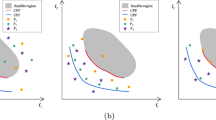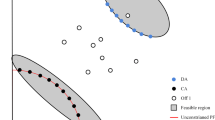Abstract
Infeasible solutions are helpful for finding the feasible regions, but how many feasible and infeasible solutions should be invested to achieve the optimal search efficiency remains to be further studied. Combined with the recently proposed collaborative constrained multi-objective framework, the contributions of the helper population and original population in different types of CMOPs are discussed. It is unreasonable to assign equal resources to these two populations in different CMOPs and different searching stages. This paper aims to investigate resource allocation in a constraint environment to efficiently utilize the limited resources and obtain a better performance. Therefore, the concept of return on investment (ROI) is first introduced to measure the contributions of two populations, and then guide the population size allocation (APS). To prevent the ROI from continuously declining as the population size decreases, an evolutionary resource allocation strategy (AER) is proposed to adjust their evolutionary state according to the cooperative relationship, and to further increase their ROI and again compete for population size, to maximize the evolutionary efficiency of the two populations in competition and cooperation. The proposed CCMODRA is compared with seven popular algorithms that cover three types of CMOEAs and test them on three benchmarks that cover four types of CMOPs. The comprehensive performance of CCMODRA is better than the other seven CMOEAs on 71% of the 3-objective CDTLZs, 57% of the 5-objective CDTLZs and 46% of the MWs. The effectiveness of the APS and AER strategies are verified on generating contribution solutions and DOC test problems. In addition, the total profit obtained by CCMODRA in the knapsack problem with capacity constraints is improved by 0.2% to 216% compared with the other seven algorithms.
















Similar content being viewed by others
Data Availability
The datasets generated and analysed during the current study are available from the corresponding author on reasonable request.
References
Li Y, Lin J, Wang Z (2022) Multi-skill resource constrained project scheduling using a multi-objective discrete jaya algorithm. Appl Intell 52(5):5718–5738. https://doi.org/10.1007/s10489-021-02608-8
Li X, An Q, Zhang J, Xu F, Tang R, Dong Z, Zhang X, Lai J, Mao X (2021) A novel two-stage constraints handling framework for real-world multi-constrained multi-objective optimization problem based on evolutionary algorithm. Appl Intell 51(11):8212–8229
Pan X, Wang L, Qiu Q, Qiu F, Zhang G (2022) Many-objective optimization for large-scale evs charging and discharging schedules considering travel convenience. Appl Intell 52(3):2599–2620. https://doi.org/10.1007/s10489-021-02494-0
Tirkolaee EB, Goli A, Hematian M, Sangaiah AK, Han T (2019) Multi-objective multi-mode resource constrained project scheduling problem using pareto-based algorithms. Computing 101(6):547–570
Zhao H, Chen ZG, Zhan ZH, Kwong S, Zhang J (2021) Multiple populations co-evolutionary particle swarm optimization for multi-objective cardinality constrained portfolio optimization problem. Neurocomputing 430:58–70
Li K, Wang R, Zhang T, Ishibuchi H (2018) Evolutionary many-objective optimization: a comparative study of the state-of-the-art. IEEE Access 6:26194–26214. https://doi.org/10.1109/ACCESS.2018.2832181
Tian Y, Si L, Zhang X, Cheng R, He C, Tan K, Jin Y (2021) Evolutionary large-scale multi-objective optimization: a survey. ACM Comput Surv 1:1–34
Wang Y, Li JP, Xue X, Bc Wang (2020) Utilizing the correlation between constraints and objective function for constrained evolutionary optimization. IEEE Trans Evol Comput 24(1):29–43. https://doi.org/10.1109/TEVC.2019.2904900
Coello CAC (2019) Constraint-handling techniques used with evolutionary algorithms. In: Proceedings of the Genetic and Evolutionary Computation Conference Companion, GECCO 2019, Prague, Czech Republic, July 13-17, 2019, ACM. https://doi.org/10.1145/3319619.3323366 , pp 485–506
Jiao R, Zeng S, Li C, Jiang Y (2018) Dynamic constrained multi-objective evolutionary algorithms with a novel selection strategy for constrained optimization. In: Proceedings of the Genetic and Evolutionary Computation Conference Companion, GECCO 2018, Kyoto, Japan, July 15-19, 2018, ACM. https://doi.org/10.1145/3205651.3205653, pp 213–214
Li K, Chen R, Fu G, Yao X (2019) Two-archive evolutionary algorithm for constrained multiobjective optimization. IEEE Trans Evol Comput 23(2):303–315. https://doi.org/10.1109/TEVC.2018.2855411
Ming M, Trivedi A, Wang R, Srinivasan D, Zhang T (2021) A dual-population-based evolutionary algorithm for constrained multiobjective optimization. IEEE Trans Evol Comput 25 (4):739–753. https://doi.org/10.1109/TEVC.2021.3066301
Tian Y, Zhang T, Xiao J, Zhang X, Jin Y (2021) A coevolutionary framework for constrained multiobjective optimization problems. IEEE Trans Evol Comput 25(1):102–116. https://doi.org/10.1109/TEVC.2020.3004012
Deb K, Pratap A, Agarwal S, Meyarivan T (2002) A fast and elitist multiobjective genetic algorithm: Nsga-ii. IEEE Trans Evol Comput 6(2):182–197. https://doi.org/10.1109/4235.996017
Cheng R, Jin Y, Olhofer M, Sendhoff B (2016) A reference vector guided evolutionary algorithm for many-objective optimization. IEEE Trans Evol Comput 20 (5):773–791. https://doi.org/10.1109/TEVC.2016.2519378
Jan MA, Tairan N, Khanum RA (2013) Threshold based dynamic and adaptive penalty functions for constrained multiobjective optimization. In: 2013 1st International conference on artificial intelligence, modelling and simulation. https://doi.org/10.1109/AIMS.2013.16, pp 49–54
Jiao R, Zeng S, Li C, Yang S, Ong YS (2021) Handling constrained many-objective optimization problems via problem transformation. IEEE Trans Cybern 51(10):4834–4847. https://doi.org/10.1109/TCYB.2020.3031642
Fan Z, Fang Y, Li W, Cai X, Wei C, Goodman E (2018) Moea/d with angle-based constrained dominance principle for constrained multi-objective optimization problems. Applied Soft Computing, p 74. https://doi.org/10.1016/j.asoc.2018.10.027
Ying WQ, He WP, Huang YX, Li DT, Wu Y (2016) An adaptive stochastic ranking mechanism in moea/d for constrained multi-objective optimization. In: 2016 International Conference on Information System and Artificial Intelligence (ISAI). https://doi.org/10.1109/ISAI.2016.0115, pp 514–518
Ning W, Guo B, Yan Y, Wu X, Wu J, Zhao D (2017) Constrained multi-objective optimization using constrained non-dominated sorting combined with an improved hybrid multi-objective evolutionary algorithm. Eng Optim 49(10):1–20. https://doi.org/10.1080/0305215X.2016.1271661
Strauch M, Cord AF, Patzold C, Lautenbach S, Kaim A, Schweitzer C, Seppelt R, Volk M (2019) Constraints in multi-objective optimization of land use allocation repair or penalize? Environ Model Softw 118:241–251
Samanipour F, Jelovica J (2020) Adaptive repair method for constraint handling in multi-objective genetic algorithm based on relationship between constraints and variables. Appl Soft Comput 90:106143. https://doi.org/10.1016/j.asoc.2020.106143
Fan Z, Li W, Cai X, Li H, Wei C, Zhang Q, Deb K, Goodman ED (2019) Push and pull search for solving constrained multi-objective optimization problems. Swarm Evol Comput 44:665–679. https://doi.org/10.1016/j.swevo.2018.08.017
Liu ZZ, Wang Y (2019) Handling constrained multiobjective optimization problems with constraints in both the decision and objective spaces. IEEE Trans Evol Comput 23(5):870–884. https://doi.org/10.1109/TEVC.2019.2894743
Vodopija A, Oyama A, Filipic B (2019) Ensemble-based constraint handling in multiobjective optimization. In: Proceedings of the Genetic and Evolutionary Computation Conference Companion, GECCO 2019, Prague, Czech Republic, July 13-17, 2019, ACM. https://doi.org/10.1145/3319619.3326909, pp 2072–2075
Rahi KH, Singh HK, Ray T (2019) Investigating the use of sequencing and infeasibility driven strategies for constrained optimization. In: 2019 IEEE Congress on Evolutionary Computation (CEC), pp 1642–1649. https://doi.org/10.1109/CEC.2019.8790239
Zhou A, Zhang Q (2016) Are all the subproblems equally important? resource allocation in decomposition-based multiobjective evolutionary algorithms. IEEE Trans Evolutionary Computation 20(1):52–64
Lin Q, Jin G, Ma Y, Wong K, Coello CAC, Li J, Chen J, Zhang J (2018) A diversity-enhanced resource allocation strategy for decomposition-based multiobjective evolutionary algorithm. IEEE Trans Cybernetics 48(8):2388–2401
Wang L, Pan X, Shen X, Zhao P, Qiu Q (2021) Balancing convergence and diversity in resource allocation strategy for decomposition-based multi-objective evolutionary algorithm. Appl Soft Comput 100:106968. https://doi.org/10.1016/j.asoc.2020.106968
Cai X, Li Y, Fan Z, Zhang Q (2015) An external archive guided multiobjective evolutionary algorithm based on decomposition for combinatorial optimization. IEEE Trans Evolutionary Computation 19 (4):508–523
Zhang N, Huang Y, Cai X (2015) A two-phase external archive guided multiobjective evolutionary algorithm for the software next release problem. In: Bio-Inspired Computing - Theories and Applications - 10th International Conference, BIC-TA 2015, Hefei, China, September 25-28, 2015, Proceedings, pp 664–675
Jain H, Deb K (2014) An evolutionary many-objective optimization algorithm using reference-point based nondominated sorting approach, part II: Handling constraints and extending to an adaptive approach. IEEE Trans Evol Comput 18(4):602–622. https://doi.org/10.1109/TEVC.2013.2281534
Ma Z, Wang Y (2019) Evolutionary constrained multiobjective optimization: Test suite construction and performance comparisons. IEEE Trans Evol Comput 23(6):972–986. https://doi.org/10.1109/TEVC.2019.2896967
Zitzler E, Thiele L (1999) Multiobjective evolutionary algorithms: a comparative case study and the strength pareto approach. IEEE Trans Evol Comput 3(4):257–271
Funding
This work was supported in part by Natural Science Foundation of Zhejiang Province (LQ20F020014), in part by the Key projects of Zhejiang Joint Fund (LZJWZ22E090001), in part by Key Projects of Science and Technology Development Plan of Zhejiang Province (2018C01080).
Author information
Authors and Affiliations
Contributions
Xiaotian Pan: Methodology, Writing, Experiments. Liping Wang: Supervision. Menghui Zhang: Experiments. Qicang Qiu: Data curation, Editing.
Corresponding author
Ethics declarations
Conflict of Interests
The authors declare that they have no conflict of interest.
Additional information
Ethical approval
This article does not contain any studies with human participants or animals performed by any of the authors.
Informed Consent
All authors agreed with the content and gave explicit consent to submit and also obtained consent from the responsible authorities at the institute.
Publisher’s note
Springer Nature remains neutral with regard to jurisdictional claims in published maps and institutional affiliations.
Rights and permissions
Springer Nature or its licensor holds exclusive rights to this article under a publishing agreement with the author(s) or other rightsholder(s); author self-archiving of the accepted manuscript version of this article is solely governed by the terms of such publishing agreement and applicable law.
About this article
Cite this article
Pan, X., Wang, L., Zhang, M. et al. A dynamic resource allocation strategy for collaborative constrained multi-objective optimization algorithm. Appl Intell 53, 10176–10201 (2023). https://doi.org/10.1007/s10489-022-03820-w
Accepted:
Published:
Issue Date:
DOI: https://doi.org/10.1007/s10489-022-03820-w




